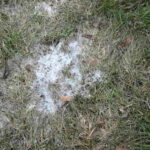
Frost seeding vs. dormant seeding: At first glance, these overseeding techniques might seem the same. Both are cool weather seeding methods that give your cool-season grass a head start germinating in spring.
The difference mainly lies in when you sow the seeds. Frost seeding happens during the late winter or early spring while the ground is still freezing and thawing. Meanwhile, dormant seeding takes place in late fall or early winter before fully freezing conditions set in.
What Makes Frost Seeding and Dormant Seeding Different?

Both frost and dormant seeding offer a backup plan for those who may have skipped the prime overseeding times in fall or spring. As a bonus, with the seeds germinating early in spring, it helps crowd out weeds that try to make themselves at home on your lawn.
But remember, these methods might not be as successful as regular overseeding strategies during ideal conditions.
*Note: If you’re unsure about the right time for overseeding, check out our easy guide on “Best Time to Aerate and Overseed a Lawn.”
Here are the main differences to help you decide what fits best with your schedule and lawn’s needs:
1. Time of Seeding

- Ideal Time for Frost Seeding: You can use this method at the end of winter or early spring (usually February or March, depending on your location). More specifically, you want to seed when you are still dealing with some cold nights and sporadic frost.
Best performed during late winter when freeze-thaw cycles are frequent.
- Ideal Time for Dormant Seeding: It happens in late fall or early winter (typically from late October to mid-November). It’s exactly what it sounds like – you’re planting seeds while the ground is too cold for anything to grow.
The best time is when the soil temperature drops below a chilly 40 to 50 degrees Fahrenheit. That’s usually before the ground freezes, followed by several inches of snow cover throughout winter.
2. Primary Purpose
- Primary Use for Frost Seeding: Farmers often use frost seeding to bulk up their pastures. This overseeding method is a simple way to introduce new types of grass or legumes into existing vegetation, thanks to the natural freeze-thaw cycle that helps bury the seeds in the soil.
However, it also can be handy for residential lawns. It’s a good option if you have a clover lawn or lack time for soil prep before seeding.
- Primary Use for Dormant Seeding: It works great for cool-season lawns with bare spots or thinning grass. It’s a more popular method among homeowners than frost-seeding.
Here is our complete guide on “What is Dormant Seeding? And How to Dormant Seed Your Lawn.”
3. Suitable Grass Types

- Suitable Grass Types for Frost Seeding: Frost seeding isn’t suitable for all types of grass. For the best results, you want to stick with species like annual or perennial ryegrass, tall fescue, and clover. These grasses have good germination rates and can effectively thrive in this seeding method.
- Suitable Grass Types for Dormant Seeding: This process suits a wider range of grass species than frost seeding. While Kentucky bluegrass, fine fescue, and perennial ryegrass are the top options for homeowners when doing dormant seeding, other mixes suitable for your local climate might work well, too.
*Note: Consult with a lawn-care professional or your local nursery to find out what types of grass are best suited for dormant seeding in your region.
4. Level of Preparation
- How to Prepare for Frost Seeding: Frost seeding is great because it’s simple. There is no need to break out the tiller and soil amendments. All you have to do is spread your selected grass seeds over the frozen ground.
The repeated process of freezing at night and thawing during daytime naturally moves the seed into the soil, paving the way for germination when temperatures increase.
- How to Prepare for Dormant Seeding: Compared to frost seeding, dormant seeding requires a bit more work upfront. Start by mowing the lawn to about 2 inches high, and then rake over any bare or thinning spots on your lawn.
This preparation step helps ensure better seed-to-soil contact, vital for successful germination in springtime.
5. Germination Success Rate
- Frost Seeding: A study from Kansas State University suggests that February is a better month for winter seeding tall fescue than December. With April’s arrival, lawns seeded in February boasted a lush 73% grass cover rate.
- Dormant Seeding: The same study reveals that dormant seeding in December resulted in only 50% grass coverage by April, significantly less than in February or even March.
Remember that weather greatly impacts the success of both frost and dormant seeding. Perfect freeze-thaw cycles are essential for frost seeding, allowing seeds to sink into the soil before spring.
While dormant seeding, if winter is too mild, early germination could kill off your seeds. Additionally, without enough snow cover, wind or birds might reduce germination rates by scattering the seeds.
*Note: Traditional fall overseeding, specifically from September to October, remains superior, with germination rates up to 91.6% to 99% and lesser risks due to more stable temperatures. The regular overseeding method reduced seed mortality by 30% to 50% compared to frost or dormant seeding.
FAQ About Frost Seeding and Dormant Seeding
Which method is better for your lawn: dormant seeding or frost seeding?
Choose dormant seeding for a broader selection of cool-season grass seeds and generally more consistent results.
If you prefer minimal soil prep and are working with ryegrass, fescue, or clover, go with frost seeding. Frost seeding is also good if you can’t get to planting until late winter.
What maintenance does each method need after seeding?
After frost seeding, just wait. The weather does the work by pushing seeds into the soil with freezing and thawing. When it gets warmer, look out for new grass sprouts.
Dormant seeding might need a little help. After planting, if there’s no rain or snow in the forecast, give your seeds a light watering – only about 0.05 to 0.10 inches. However, hold off watering when it’s freezing outside (below 32 degrees Fahrenheit), as it can harm your lawn.
What if the seeds don’t grow come springtime?
Whether you choose frost or dormant seeding, if the grass doesn’t sprout in spring, give it more time since some seeds are slow to wake up. If nothing happens by late spring, though, you might need to reseed. Here is our guide on “How to Overseed a Lawn in 8 Simple Steps.”
Pro Tip: If your seeds don’t sprout, check the soil moisture and temperature to ensure they’re in that sweet spot grass loves for growing. Sometimes, tweaking watering practices helps kick-start germination. Check out our article “How Often to Water Grass Seed.”
Hire a Lawn Care Professional
Frost and dormant seeding can give your lawn a head start in spring because the seeds have a better chance to take root before weeds can get in the way. But remember, these methods aren’t always reliable. The weather plays a big factor on success rate, even when you use the toughest cool-weather grass seed mix.
Don’t know how to get started with frost or dormant seeding? Or are you unsure if these ways fit your lawn? Call in a pro. LawnStarter connects you with the best local lawn care professionals. They figure out what your yard needs and make it happen.
Main Photo Credit: be free / Adobe Stock Free / License





